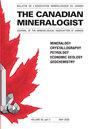Pseudoleucite syenites at Loch Borralan, Scotland: Petrology and a genetic model
IF 1.5
4区 地球科学
Q3 MINERALOGY
引用次数: 0
Abstract
The alkaline Loch Borralan intrusion (Assynt Region, NW Highlands of Scotland) consists of a composite arrangement of several ultramafic to felsic plutonic rock bodies which were emplaced around 430 Ma into the Moine Thrust Zone during the Caledonian Orogeny. Some of the Loch Borralan rocks are ultrapotassic and contain pseudoleucite, i.e., a pseudomorph of alkali feldspar and nepheline after leucite. In total, 25 samples have been investigated, representing garnet-bearing pseudoleucite syenites and accompanying rock types such as nepheline-garnet-bearing syenites, alkali feldspar syenites, an amphibole syenite, a biotite-clinopyroxene syenite, and calcite-bearing glimmerites. Pseudoleucite is always associated with garnet, biotite, orthoclase, and minor clinopyroxene and titanite. Mineral chemical data indicate rather primitive magma compositions with no major differences between the various investigated main rock units. The abundant occurrence of up to 2 cm large, mostly euhedral pseudoleucite crystals and petrological phase considerations suggest that magmatic leucite physically separated from its host magma as a flotation cumulate. Based on our data and a comparison with previous field-based and experimental work, K-rich basanitic to tephriphonolitic melts that originated from a K-enriched mantle source may be parental to these rocks. The high liquidus temperatures at low pressures (e.g., ∼1100 °C at 1 bar PH2O) required to crystallize leucite could have resulted from the ascent of successive melt batches in a composite intrusion. Later melt batches would increase the temperature in earlier, already partially cooled batches, causing an increase in temperature and a decrease in pressure during ascent. The subsequent decomposition of leucite to pseudoleucite is interpreted to result from either dry breakdown or autometasomatism, i.e., involvement of late-magmatic fluids.苏格兰博兰湖的假亮氨酸正长岩:岩石学和成因模型
碱性博拉兰湖侵入体(苏格兰西北高地的亚述地区)由几个超镁铁质到长英质深成岩体的复合排列组成,这些岩体在加里东造山运动期间侵位于约430 Ma的莫因冲断带。博兰湖的一些岩石是超钾质的,含有假亮氨酸,即在亮氨酸之后的碱长石和霞石的假变体。总共调查了25个样品,代表了含石榴石的假白榴石正长岩和伴生岩石类型,如霞石含石榴石正长岩、碱性长石正长岩,角闪石正长岩、黑云母斜辉石正长岩和含方解石的微光岩。假白榴石通常与石榴石、黑云母、正长石、小单斜辉石和钛矿伴生。矿物化学数据表明,在所调查的各种主要岩石单元之间,岩浆成分相当原始,没有重大差异。高达2厘米的大的、主要是自形的假亮氨酸晶体的大量存在和岩石学相的考虑表明,岩浆亮氨酸作为浮选堆积物与其宿主岩浆物理分离。根据我们的数据以及与先前基于现场和实验的工作的比较,源自富钾地幔源的富钾碱性到温铁响岩熔体可能是这些岩石的母体。使亮氨酸结晶所需的低压(例如,~1100°C,1巴PH2O)下的高液相线温度可能是由复合物侵入中连续熔融批次的上升引起的。较晚的熔融批次会使较早的、已经部分冷却的批次的温度升高,从而在上升过程中导致温度升高和压力降低。亮氨酸随后分解为假亮氨酸被解释为干分解或自交代作用的结果,即晚期岩浆流体的参与。
本文章由计算机程序翻译,如有差异,请以英文原文为准。
求助全文
约1分钟内获得全文
求助全文
来源期刊

Canadian Mineralogist
地学-矿物学
CiteScore
2.20
自引率
22.20%
发文量
45
审稿时长
4-8 weeks
期刊介绍:
Since 1962, The Canadian Mineralogist has published papers dealing with all aspects of mineralogy, crystallography, petrology, economic geology, geochemistry, and applied mineralogy.
 求助内容:
求助内容: 应助结果提醒方式:
应助结果提醒方式:


